#cult of eleusis
Text
UPG: On the nature of the gods, ancestors, and maybe also mystery cults
What is a god but many of the blessed dead coming together in an afterlife. Many joined together across space and time to form a consciousness. Together they can speak and act and live. To me that is the mystery cult. What is a blessed afterlife but joining with a god. And when you pray and libate to a god you become part of them. In life and death you then can join with many gods and in life they live close to you.
They love to come together around you. Each time you pray and give offerings you add to them as a god. You give part of yourself and those blessed dead that are always around us can join to become part of that god to be near you.
Giving to a god is also a way to give to the blessed dead or our ancestors. There then is a way that ancestral gods mean something. Our ancestors can remember what it means to be part of a god they themselves sacrificed to. Though I should say, that doesn’t mean you cannot worship gods who are not ancestral to you. You still help a god come together around you by giving to them.
So libate! The gods live and they live around us. They can hear and feel us and they are always with us.
#hellenic deities#hellenic polytheism#helpol#mystery cults#Eleusis#Eleusinian mysteries#Dionysian mysteries#cthonic gods#12 olympians#zeus#hera#demeter#hestia#poseidon#hades#dionysus#hermes#apollon#apollo#artemis#ares#athena#hephaestus#persephone#kore#theoi#theoi worship#greek gods#dionysus worship#Aphrodite
24 notes
·
View notes
Text
Kala Eleusinia!

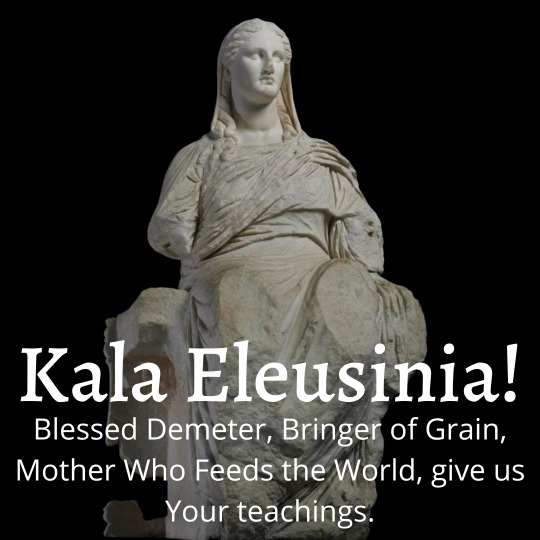


Last night began the Greater Eleusinian Mysteries - Eleusinia ta Megala - which are sadly lost to us now. But to many Hellenists, myself included, this is still one of the most sacred festivals and we celebrate the best we can.
As Demeter mourned the loss of Her beloved daughter, She came to Eleusis in the guise of an old woman and asked King Celeus for shelter. He brought Her into his palace and placed his sons in Her care. To reward him for this kindness, She began the process of making one of his sons immortal, only to be stopped by his wife, Metanira, who panicked when she saw an old woman putting her baby into an open flame.
Demeter instead taught the other son, Triptolemus, the secrets of agriculture and commended Celeus to build Her a temple. It was here that She waited, withholdings Her gifts from the earth, until Persephone was returned to Her at last.
Eleusis became a major cult center for the Goddesses, and hosted the Mysteries: the Lesser Mysteries once a year, and the Greater Mysteries every four years. Among that which was revealed in the Mysteries was agricultural knowledge and the secret to a blessed afterlife under Persephone.
#hellenism#hellenic polytheism#hellenic paganism#hellenic pagan#persephone#demeter#eleusis#eleusinian mysteries#helpol#mystery cult
195 notes
·
View notes
Text
The ancient city of Eleusis in Greece was the site of one of the most mysterious and revered religious rites of ancient Greece, the Eleusinian Mysteries. Now Eleusis, home of the mystery school, has been designated the Culture Capital of Europe.
#Eleusis#Elefsina#Greece#Eleusinian Mysteries#esoteric#cult#secret school#ancient#history#ancient origins
28 notes
·
View notes
Text
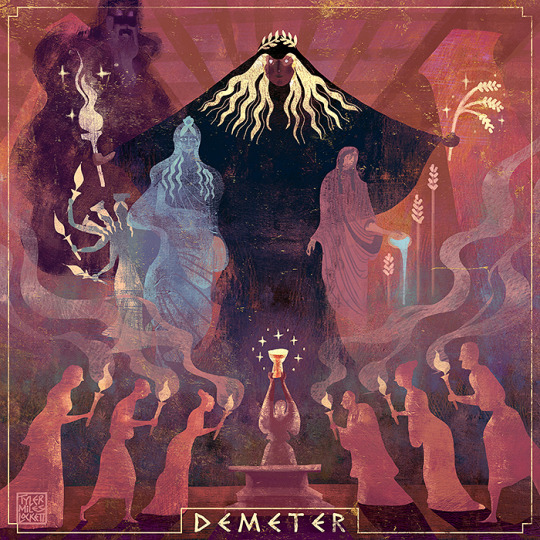
DEMETER
“I begin to sing of rich-haired Demeter, awful goddess —of her and her trim-ankled daughter whom Aidoneus (Hades) rapt away, given to him by all-seeing Zeus the loud-thunderer.”
(-Homeric Hymn, translated by H.G. Evelyn white)
DEMETER (duh-MEET-er), is the goddess of harvest, agriculture, fertility, and grains. She is the central figure in the mystery Cult of Eleusis,where citizens made a pilgrimage to Eleusis to partake in a festival and initiation ritual tied to the myth of Demeter and her daughter Persephone’s abduction by Hades into the underworld. This ceremony would initiate a citizen, provide some spiritual insight, thereby guaranteeing a better position in the afterlife. In my depiction, Demeter holds out her torch, in search of her abducted daughter, and an ear of wheat grain to symbolize her role in agriculture. Tto the left we have the main players of the missing daughter myth. A misty Hades behind, and Persephone in front, with triple-bodied Hekatebeside, who helped Demeter find her daughter, and became Persephone's attendant in the underworld. On the right we have a woman pouring libations to help the wheat grow, then Demeter holding the cut grain, symbolizing the cyclical nature, and transience of life.
Unfortunately, as the crime of revealing the inner secret ceremony was punishable by death, we can't know for sure what took place in the inner sanctum during the main ritual. What we do know is that something was “drunk” and something was "seen". Many believe that the Kykeon drink offered to initiates would produce a psychotropic, hallucinatory effect. Perhaps the drink was tainted with ergot (rotten barley fungi), or maybe mushrooms. Apparently, the ritual had three stages, (mirroring Persephone’s underworld journey); the descent, the search, and the ascent. Some believe the final act shown to the initiate was the cutting of an ear of grain, to symbolize the cyclical death and rebirth of nature.
Want to own my Illustrated Greek myth book jam packed with over 130 illustrations like this? Support my book kickstarter "Lockett Illustrated: Greek Gods and Heroes" coming in early 2024. check my bio LINKTREE
#Thrumb hash#pagan#hellenism#greek mythology#tagamemnon#mythology tag#percyjackson#dark academia#greek#greekmyths#classical literature#percy jackon and the olympians#pjo#homer#iliad#classics#mythologyart#art#artists on tumblr#odyssey#literature#ancientworld#ancienthistory#ancient civilizations#ancientgreece#olympians#greekgods#agamemnon#troy#trojanwar
329 notes
·
View notes
Photo

Aeschylus
Aeschylus (c. 525 - c. 456 BCE) was one of the great writers of Greek Tragedy in 5th century BCE Classical Athens. Known as 'the father of tragedy', the playwright wrote up to 90 plays, winning with half of them at the great Athenian festivals of Greek drama. Perhaps his most famous work is Prometheus Bound which tells the myth of the Titan punished by Zeus for giving humanity the gift of fire. All of his surviving plays are still performed today in theatres across the world. An innovator of the genre, Aeschylus is said to have described his work as 'morsels from the feast of Homer'.
Aeschylus' Life
5th century BCE Athens was blessed with three great tragedians: Aeschylus, Euripides (c. 484 - 407 BCE), and Sophocles (c. 496 - c. 406 BCE). The senior of the three, Aeschylus was born in Eleusis in c. 525 BCE. Aeschylus' father was Euphorion, and ancient sources claim the family belonged to the aristocracy. Living through the Persian wars, Aeschylus almost certainly participated in such famous and decisive battles as Marathon and Salamis. His brother Kynegeiros was killed in the former battle and his other sibling Ameinias fought at the latter. Aeschylus' epitaph, said to have been self-penned, stated nothing of his success as a playwright but only that he had fought at Marathon. These experiences and the transformation of Athens' political structure as it embarked on the road to democracy greatly influenced the playwrights' work.
Other snippets of biography, which have survived from antiquity, reveal that Aeschylus was once prosecuted for revealing details of the secret Eleusinian mysteries cult but managed to prove his innocence. Sometime after 458 BCE Aeschylus travelled to Sicily, visiting Syracuse at the invitation of Hieron I, and around 456 BCE he died on the island in the town of Gela. Aeschylus' plays were already recognised as classics and their public performances were given particular privileges. His son Euphorion and nephew Philocles both became noted dramatists in their own right.
Continue reading...
33 notes
·
View notes
Text
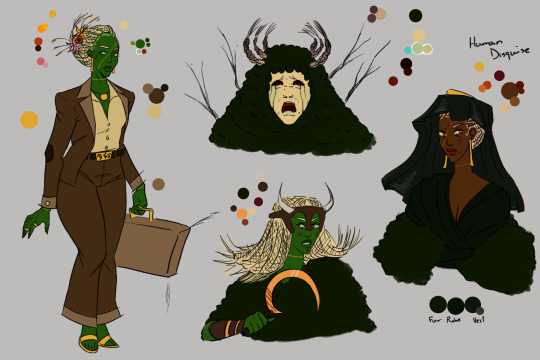
Fourth in the Series: Demeter!
More info under the cut
Lore notes:
-Demeter is obviously a fertility goddess. Not in the LO sense, she's just a fertility goddess, is venerated as one, and is one of the figureheads of a cult dating back to to the neolithic age. -She did not fight on the front lines during the titanomachy; she was the supply force of ambrosia and thus did not have to fight much. However, at the tail end of the war, her farm was ransacked by the titans and she was left with a scar crossing her face. Her fields were burnt to a crisp and many nymphs were lost in the process. -Demeter is made of earth, and is a perfect equal to Poseidon, made of the sea. -She raised Persephone in the mortal realm -She lost her bid for queen of the mortal realm, which occurred in the midst of her banishment from Olympus. Hades voted in favor of her, after they secured a deal regarding the volcanoes, but Zeus, Hera, and Poseidon voted against her. -Top center is her true form, only seen in times of great despair. -Everyone on Olympus is waiting for Demeter's inevitable return.
Design notes:
-Demeter is made of fresh earth. She is a stronger, more vibrant green than Persephone because she was designed after tall forest/jungle plants, which have more chlorophyll to tolerate the sun's rays and are thus darker but less colorful (see: Persephone) -Her hair is wheat/cereal stalks, usually tied into a cornucopia style "bun" -Her hair always defies gravity in some way -She wears a lot of furs and natural materials, and her clothes are always some shade of green, brown, or yellow. -In her hair are three flowers: 1. A poppy, her sacred flower 2. A pink lily, modelled after Persephone and 3. An orange lily, modeled after Persephone's act of wrath. -She has a human disguise due to her time with mortals, and later, her refuge at Eleusis. -Demeter has "horns" of some kind whenever she is in a threatened position. The top and bottom middle are her at times of great despair.
#lore olympus#demeter#redesign#lore olympus demeter#demeter lore olympus#lore olympus redesign#lo#anti lo#anti lore olympus#lo edit#lore olympus edit
393 notes
·
View notes
Text
The myth of Dionysos (4)
The Dictionary of literary myths does not have just one article about Dionysos… But two! And since I translated the first, let’s journey through the second: it is titled “Dionysos: The evolution of the literary myth”, and it was written by Ann-Déborah Lévy-Bertherat.
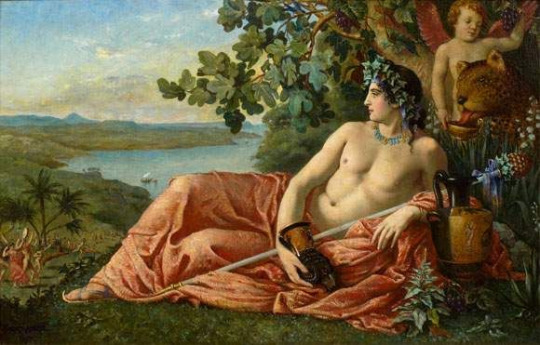
According to the imagery of the Ancient Greeks, Dionysos is supposed to be a young god – he is often depicted as a teenager, sometimes even as a child. This perhaps explains why his Greek name was thought to be the counterpart of the Phrygian “Dioskouros”, “the boy of Zeus”. However, it seems more plausible to link Dionysos’ name to Nysa, both nurse and homeland of the god. But no matter which of these explanations is right: both highlight and insist on a foreign origin for the god. A foreign origin that we know to be purely mythical rather than historical – indeed, the Mycenaean texts proved that the cult of Dionysos was implanted in Greece since a very, very old time, and was not a “recent importation” as classical Greeks believed.
But then, why make Dionysos a “foreign god”? Maybe because, in a symbolic way, it is important for Dionysos to be a god that “comes and goes”, a “god that arrived” – or maybe, it was a much needed element to explain his strange, bizarre and frightening character.
I/ Births and rebirths of Dionysos
Semele, a mortal woman loved by Zeus, died because of Hera’s jealousy: she asked her divine lover to appear before her in all of his glory, but this resulted in her death struck by his lightning. Removing the child she was bearing in her womb, Zeus placed the unborn into his own thigh, where the baby completed his growth. As such, Dionysos knew a double-birth, and his cult was deeply marked by this. One of the Dionysiac rites is the ritual of the liknites (child in crib) – where a child has to disappear and be searched by women in vain, for he will only reappear one year later.

The Passion of Dionysos: The myths of Dionysos’ childhoods and wanderings depict him as a persecuted god. One time he is dismembered, boiled and devoured by the Titans before being resurrected by Demeter. Another time Hera curses with madness Semele’s sister, Ino, first nurse of the god. In a third tale pirates kidnap the child to sell him as a slave. Homer, in the Iliad, retells of how Lycurgus, armed with an axe and a desire to kill, hunted down Dionysos and his nymph-nurses – the child had to throw himself into the sea, where he was saved by Thetis. The true “passion” of Dionysos (in the Christian meaning of the term) always suffering, always dying, but always resurrecting, seems to be a symbol of the vegetal cycle. As a result, it is no coincidence that the four great holidays of Dionysos are all placed between the end of December and the beginning of April – aka, between the winter solstice and the arrival of spring.
Ivy and vine: Legends insist on the ties between Dionysos and other vegetal deities, such as Cybele or Rhea – two incarnations of the great Earth-mother, two deities that shield Dionysos from Hera’s revenge. There are the agrarian nymphs that constantly surround the god; there is his lover, Ariadne, that was originally a Minoan goddess of vegetation; and there is of course Demeter, to which he is tied through the Mysteries of Eleusis (and Pindar even goes as far as making Dionysos and Demeter a couple). Dionysos is also called Bacchus (a named which, according to Euripides, comes from “bacchos”, the “branch” the “bough”) ; he is said to be a “ploutodotes”, a “wealth-giver” ; he was believed to give strength to plants and to help them grow ; and among his numerous attributes, his most prominent ones are the ivy (of which he is crowned) and the grapevine (which he offered to the world). These two plants have always a savior role in his myths. It was said that the child Semele bore was protected from the lightning by ivy ; the pirates were frightened when ivy and vine started growing around their ship’s mast ; a nymph hunted by Lycurgus turned herself into vine to choke the murderous king… And yet, these two plants are such a contrast they can only make the god ambiguous: ivy is coldness and sterility, where the grapevine is warmth and generosity. Dionysos is almost most famed as the god of wine: it is the wine that symbolizes the presence of the gods during festivals; during the Lenaia festival (January-February) the new wine is offered to the god (symbolized as a bough-decorated mask). Dionysos “polygethes” (joyful, happy) is said, according to Euripides, to have the power to “laugh and put to sleep all our problems”.
Fertility and fecundity: This god, friend of the nymphs, who found a home with Thetis at the bottom of the sea, whose statue is ritually plunged in water at Halai, who was said to have entered Athens on a naval chariot, has too many affinities with water and humidity (an universal symbol of fertility) for his power to limit itself just to plants. Indeed, let us take a look at his cohorts and parades: w find in there donkeys, goats and bulls, usually painted in an ithyphallic position; and he is surrounded by Satyrs and Silenes whose lubricity and lust are meant to parallel the chastity of the Maenads. Dionysos himself, during the Anthesteria festival (February-march) knows a physical and sexual union with the Basilinna, and by doing so ensures one year of fecundity for all of Athens. The exaltation of fertility in Dionysos’ cult is most expressed through phallophoria – but the particularity of Dionysos is that he depicts a complete and “full” fecundity, with both its masculine and feminine attributes. Dionysos, in his myth like in his cult, is surrounded by women: Aeschylus calls him “effeminate”, explaining his youthfulness (he hasn’t grown a beard or body hair yet), and his clothes (he usually wore the women’s peplum). Some even depict him as an androgynous figure, and the ambiguity of his sex reminds the one of the hermaphrodite and their “ideal fecundity”. The French poet Baudelaire will even interpret the thyrsus, a long, leafed staff held by the followers of the god, as the union of the masculine symbol (the straight staff) and the feminine one (the curvy boughs wrapped around it). Dionysos is “polygethes” and “ploutodotes” – but reducing Dionysos to this sole role would be removing from him his “dark side”, the eviler part of his power. For Homer calls him “mainomenos”, the “demented one”. He is a god that disturbs, he is a god that break the order.
More about this next time, in “The Frenzied God”!
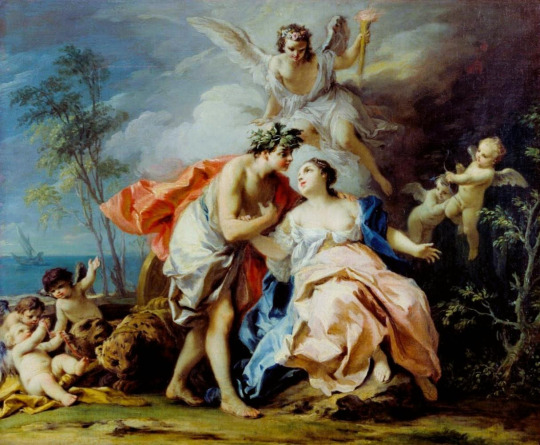
48 notes
·
View notes
Text
The Adeia - a modern festival to Demeter

Historically, it’s often during times of hardships and crisis that new cults would be established and religious innovations would appear. This one is no different. It’s through discussion with @iliosflower that the idea of creating a new festival, one that would more accurately respond to modern problematics, came to fruition. This is what we’d like to explain in this post and hope that the idea finds an echo, and hopefully, validation from the wider community.
Why? What is it supposed to do?
On a global scale, we’re dealing with a climate crisis that is putting food sources at risk. On a more local level, conflicts and abnormal weather are creating risks of bad harvests, resources shortages and/or inflations.
We are aware that not everyone is impacted directly by the current ongoing issues, but we hope that this festival (or at least the idea) can be useful beyond these and be seen through a wider scope of praying for food security at large.
We named the festival Adeia, from the ancient Greek ἄδεια, which conveniently can signify both “abundance”/”plenty” and “freedom from fear”/”security”. All things the festival aims for.
How? What would the festival entail?
For whom? Demeter Soteira (the saviour) and Herakles Alexikakos (averter of evil). While this is what we thought was appropriate, we gladly encourage additions, especially if it fits your local situation (eg. Poseidon or Zeus could both make logical additions to protect from droughts or other natural disasters that impact food security).
For what? An answer to the needs of current events; fear of food shortages/wheat shortages
Purpose; invoke the Saviour and Averter of Evil, ask for their continued blessings for plentiful food in the home for you and your loved ones, thanking them for past blessings, ask them to watch over those that will be hit the hardest by the current food crisis. Ask for Herakles’ strength and forbearance in the coming year; ask for Demeter’s continued blessing of your home’s stores.
Date: 1st weekend of September (2022: 3-4th of September) / a week before Eleusinian Mysteries. These dates are based on the Northern hemisphere, feel free to make the dates match your local harvest calendar.
Ideal food offerings:
Pig; preferably piglet (if findable); fat and smoke to go up to Demeter; BBQ will do perfectly.
Rye, barley, and wheat as grains (if rice/corn or another grain is the majority grain in your area, go for that instead), baked into cakes, and/or tossed on the fire for Demeter.
Some kind of honey fritters; honey and bees are connected to Demeter, as a thank you for their pollinating the plants, flowers, and all that grows; or fruits and vegetables; to honour the “fruit of Demeter’s labour” and all she does for mankind.
Ideal drink offerings;
Grain-based drinks (see: Kykeon at her festival in Eleusis); you can get close to this with beer, mead, with a mint flavouring preferably.
Other ideas to offer;
Donate either food/money to your local food banks or charities that help in relief from food shortages.
Support local farmers/buy your groceries for this weekend solely from regional products.
Bring awareness to the current crisis and see what you can do to support others.
Make a votive offering and give it to Demeter and/or Herakles on this date.
Read the Hymn to Demeter out loud/listen to a recording of it, as a reminder of her blessings to mankind and how she relieved us from famine before.
A simple libation and prayer of thanks goes a long way; offering what you can afford/can do in your situation is historically attested and perfectly valid. Offerings should be made according to what is possible and reasonable for your means.
Feedback, discussion & questions welcome.
Sources used in the making of the festival;
Hesiod, Works and Days
Pindar, Olympian XIII
A Companion to Food in the Ancient World, Nadeau, Robin Wilkins, John
Earthquakes and the Gods: Reflections on Graeco-Roman Responses to Catastrophic Events, Fritz Graf
Demeter, Myths, and the Polyvalence of Festivals, Sarah Iles Johnston
#hellenic polytheism#hellenic religion#hellenic pagan#hellenic paganism#hellenic deities#helpol#theoi#demeter#demeterdeity#demeter deity#hellenic pantheon#hellenic prayer
360 notes
·
View notes
Text
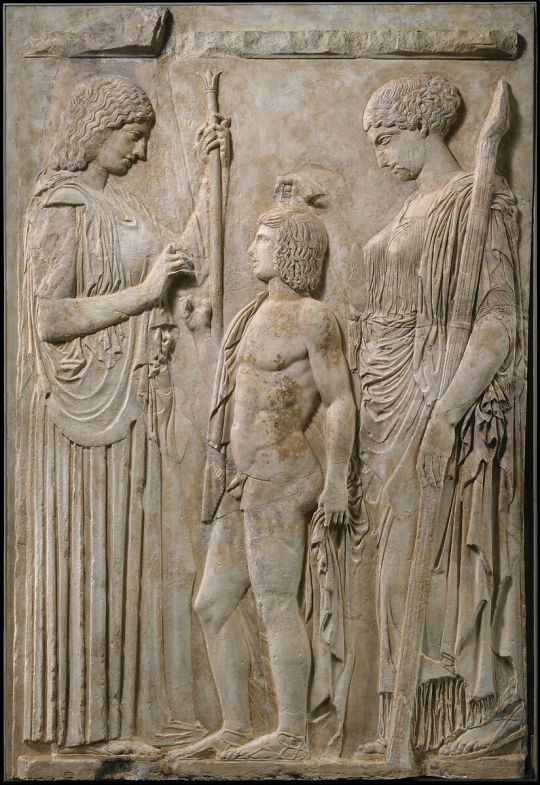
Ten marble fragments of the Great Eleusinian Relief. Roman ca. 27 BCE–14 CE. x
Demeter, the goddess of agricultural abundance, stands at the left, clad in a peplos and himation (cloak) and holding a scepter. At the right is Persephone, her daughter and the wife of Hades, the god of the underworld. She is dressed in a chiton and himation. Each goddess extends her right hand toward a nude youth, but it is no longer possible to determine what they held. The boy is thought to be Triptolemos, who was sent by Demeter to teach men how to cultivate grain. On contemporary Athenian vases, he is usually shown as a bearded adult seated in a winged chariot about to set out on his civilizing mission. The original marble relief was found at the sanctuary of Demeter at Eleusis, the site of the Eleusinian mysteries, a secret cult that was famous throughout antiquity.
The original Greek work and a number of Roman copies survive. Here the ten Roman fragments are embedded in a cast of the Greek relief. Compared to the original, the execution of the hair and drapery in the copy is sharper and accords with the style current in Augustan art.
114 notes
·
View notes
Text
Persephone Deity Guide

Who is Persephone?
Known as Prosperina to the Romans, Persephone is a Greek goddess of spring and the queen of the underworld, ruling alongside Hades. Due to her mythology, in antiquity, she is closely related to all aspects of womanhood and female initiation, including girlhood, marriage, and childbearing. (This is an ancient view of what womanhood means and does not reflect my personal views on the topic).
Parents and Siblings
Persephone’s parentage varies depending on who you ask
Demeter (her mother in the most popular variation)
Zeus (father in the most popular variation)
other variations include:
Styx (and Zeus)
Rhea (and Zeus)
Posiden (and Demeter)
She has no full blood siblings, but has plenty of half-siblings from both Demeter and Zeus, most notably:
Arion (brother)
Corybas (brother)
Plutus (brother)
all from Demeter, and
Apollo
Artemis
Athena
Dionysus
Heracles
Perseus
and many more from Zeus.
Lovers or Partners
Hades
Adonis (in some tales, in others he is more of an adoptive son to her; in some tales, he’s both. Greek gods, am I right?)
Children
In Orphic myth her children are
Melinoe
Zagreus (later turned Dionysus)
The Erinyes
Epithets
Kore, Kora, or Cora - the maiden
Nestis - the fasting one
Despoina (literally "the mistress of the house") in Arcadia.
Hagne, "pure", originally a goddess of the springs in Messenia.
Melindia or Melinoia (meli, "honey"), as the consort of Hades, in Hermione.
Malivina
Melitodes
Aristi cthonia, "the best chthonic".
Praxidike, "subterranean queen. The Eumenides' source [mother], fair-haired, whose frame proceeds from Zeus' ineffable and secret seeds."
Agauē, “venerable”
Arrētos, “she who must not be named”
As a vegetation goddess, she was called:
Kore Soteira, "the savior maiden", in Megalopolis.
Neotera, "the younger", in Eleusis.
Kore of Demeter Hagne in the Homeric hymn.
Kore memagmeni, "the mixed daughter" (bread).
Demeter and her daughter Persephone together were usually called:
The goddesses, are often distinguished as "the older" and "the younger" in Eleusis.
Demeters, in Rhodes and Sparta
The thesmophoroi, "the legislators" in the Thesmophoria.
The Great Goddesses, in Arcadia.
The mistresses in Arcadia.
Karpophoroi, "the bringers of fruit", in Tegea of Arcadia.
Notes
Persephone’s most popular story, the abduction of Persephone, is possibly derived from the ancient Sumeria myth of Ereshkigal, goddess of the underworld who was abducted by Kur, the primeval dragon of Sumerian mythology, who forced her to become ruler of the underworld against her will. Keep in mind that there are many versions and interpretations of this myth.
Another story about Persephone involves her interaction with a Nymph named Minthe, who used to be one of Hades’ lovers. Minthe boasted that she was more beautiful than Persephone and would win Hades back. Persephone didn’t take kindly to this boasting and stomped Minthe into the ground, turning her into a mint plant.
Other popular stories are Adonis and Persephone, one creation myth, as well as many more.
It’s possible that Persphone is an old Cthonic local deity of agricultural communities that was absorbed into Greek mythos.
Persephone played a part in many different festivals and rituals in the Greek and Roman world. Many festivals were held in which people would reenact her abduction and her being found again by Demeter. In Syracuse, there would be an annual sacrifice of small animals and a public drowning of bulls.
Among the cults dedicated to Persephone, the largest one was located in Sicily and Southern Italy.
For her connection to the Underworld, Persephone is often mentioned in curse tablets and on gold leaves that were buried with people who had how to act in the afterlife inscribed on them.
Modern Deity Work
Correspondences
Due to being a popular deity that was widely worshiped, the ancient correspondences of Persphone vary. Some symbols and attributes were more popular than others, and some were localized or cult-specific. Regardless, any traditional or historic correspondences will be marked with a (T).
Rocks/Stone/Crystals
Ruby
Quartz
Pink Tourmaline
Herbs/Plants
Poppies
Pomegranates
Corn
Grain
Asphodels
Willow
Animals
Pigs
Roosters
Symbols
Scepter
Torch
Festivals and Rituals
Thesmophoria is a three-day festival celebrated by most of the Greek world; though the female cult of Demeter and Persephone were known to celebrate it more. This festival was probably celebrated around October-November. In some places, this festival or certain aspects of it were exclusive to women.
Chthonia, where four old women would be chosen to sacrifice four heifers with sickles. This festival honored Demeter in connection to Persephone.
Offerings
Honey (T)
Art (statues, pinakes, etc) (T)
Pomegranate (full fruit, the seeds, or juice)
Flowers, especially wild spring flowers!
Floral scents or like perfumes, oils, or incense
Any of the items or depictions of the items listed above
Wine
Bones
Chocolate (some say specifically dark chocolate)
Acts of Devotion
Dancing to a song that reminds you of her (T)
Creating any art that reminds you of her (T)
Tend to wildflowers or your garden if you have one, or even houseplants.
Celebrate the festivals/holidays mentioned above
As always, your personal correspondences when interacting with a deity will mean much more than anything you find online, but this isn’t a bad place to start!
References and Further Reading
Persephone - Mythopedia (they also have a pretty huge reference list so please go take a peak!)
Persephone and the Seasons - Hellenic.org.au
Hymn for Persephone by Sappho (vis Sacredtexts)
Persephone - Theoi Project
Persophone - World History
(please message me if you are a follower or devotee of Persephone and would like to be added as a resource that someone could reach out to in regards to her!)
#deity deep dive#Persephone#Persephone deity#deity work#deity guide#witchcraft#hellenic#hellenic pagansim#pagan#witchblr
327 notes
·
View notes
Text
“Artemidoros, for instance, summarises the fruit's symbolism as follows: "And pomegranates are significant of injuries due to their colour and trial by torture due to their thorns and slavery and subordination due to the myth set in Eleusis". 1º Indeed, within the literature the fruit appears consistently and prominently in contexts where blood and wounding are involved.''' Taking account of this symbolism, Hera's pomegranate may have reminded her worshippers of the blood shed during childbirth. Another interpretation arises when Hera's seduction of Zeus in Nonnos' Dionysiaka is considered. As the goddess beautifies herself, she dons the garment she wore during her secret gamos with Zeus, described as still being marked with the "blood of maidenhood". 112 Since Hera's loss and recovery of virginity are significant themes in Argive cult-mythology, the pomegranate may symbolise the potential of virginal bleeding after the consummation of the gamos. The same interpretation may be applied to Hera's pomegranate on Samos, given that the secret gamos also occurred there. Therefore, while it is indeed possible to associate the pomegranate with Hera's gamos, the fruit cannot be restricted to a fertility symbol of childbirth within marriage.”
-The Stages of Hera: Deconstructing the Sacred Marriage
George Topalidis
#hera goddess#greek mythology#hera greek mythology#goddess hera#research#hera#the stages of hera#pomegranate
8 notes
·
View notes
Text

The Abduction of Persephone
In the Homeric Hymn to Demeter, we are shown the tragic tale of the abduction of Demeter’s and Zeus’s daughter Persephone; goddess of spring growth. The young girl, out picking flowers, is entranced by the beauty of a Narcissus flower when the earth opens up and Hades appears and steals her away in his chariot. Persephone cries out, but of all the gods, only Hekate hears the voice, and Helios, the sun god high above, sees the crime. Demeter, consumed by grief and neglecting her duties as an agricultural deity, disguises herself as an old woman and searches for her Daughter over the earth with torch bearing Hekate providing assistance.
In the city of Eleusis she becomes the nursemaid to a royal family and infant son; Demophon, whom she attempts to make immortal by cleansing the child with ambrosia and setting him upon the hearth fire in secret at night. But Demophon’s mother, the queen, discovers the ritual and interrupts it, preventing the child from obtaining immortality.
Because Demeter is neglecting her agricultural duties, Zeus fears for humanities survival, and sends Hermes to deliver a message to Hades, imploring him to return Persephone to her mother. Hades relents, but tricks Persephone into eating a pomegranate fruit, forever tying her to the underworld. The daughter returns to the surface, reunites with her mother, but is fated to return to the underworld for a third of the year. Demeter, now satisfied, brings back fertility to the crops and even teaches the mortals of Eleusis the secret rites and rituals which will eventually become the Eleusinian mysteries religious cult.
Persephone appears in other hero myths beside Hades, as the queen of underworld, receiving the musician Orpheus in his quest of his lost love Eurydice, and Heracles, who negotiates for the release of Theseus.
Want to own a book jam packed with over 130 illustrations like this? Support my kickstarter for my book "lockett Illustrated: Greek Gods and Heroes" coming in October. please check my LINKTREE
#pagan#hellenism#greek mythology#tagamemnon#mythology tag#percyjackson#dark academia#greek#greekmyths#classical literature#percy jackon and the olympians#pjo#homer#iliad#classics#mythologyart#art#artists on tumblr#odyssey#literature#ancientworld#ancienthistory#ancient civilizations#ancientgreece#olympians#greekgods#hades#persephone
316 notes
·
View notes
Text
The Neolithic farming communities had a nonlinear sense of time, believing that time began anew with each new year. The pregnant Mountain Mother gave birth in August when the seeds, spring-planted in her womb, had grown large. At that time the entire community came to be with her: the divine birth is the harvest of the wheat, and the first fruits were offered to the Goddess. Similar mysteries were enacted in Eleusis around Demeter, the Grain Mother. In Britain she was known as Bride, Ana, or Danu, and she was celebrated on her womb/mounds in August as late as the seventeenth century A.D. Great assemblies of witches traditionally gathered on Lammas Eve (August 1), the people believing that their welfare in the coming year depended on the performance of these sacred rites of the Corn Mother, or Harvest Queen. (The Christian church throughout Britain finally took drastic action against this "pagan cult worship." The Christian priesthood preaches linear, not cyclic time, hoping to separate "man" from the Goddess of Nature, and "God" from the great cosmic rhythms of creation. As many wise people have observed, the way to control human life is to control the rhythm of life. Pagan life was ruled by natural cyclic rhythms. The church opposed these female rhythms with linear-historic ones, thus trying to change human rhythm from natural to mechanical—which serves the industrial process but leaves human life and labor, including agricultural life and labor, quite alienated.)
-Monica Sjöö and Barbara Mor. The Great Cosmic Mother: Rediscovering The Religion of the Earth.
53 notes
·
View notes
Text
Hekate's Torchlight at Sacred Eleusis.
Among the mystery cults of ancient Greece, none were as influential as the Eleusinian Mysteries celebrated in the town of Eleusis , the mysteries of Eleusis wrrr dedicated to Demeter and her daughter Persephone. And while many aspects of the Mysteries are lost to time due to the strict vow of secrecy initiates of the Mysteries would undergo. it is known that the most central element of the mysteries was the abduction Personal by Hades, as depicted in The Homeric Hymn to Demeter. Persephone's role as queen of the underworld and her eventual return to the surface, aspects which were symbolic of the cycle of life, death, and rebirth. And while Demeter and Persephone were the central figures associated with Sacred Eleusis. They were not the only ones. Hekate, Goddess of Crossroads and witchcraft also played an integral role in the Mysteries. As told in the Homeric Hymn to Demeter.
"...only tender-hearted Hecate, bright-coiffed, the daughter of Persaeus, heard the girl from her cave...But when the tenth enlightening dawn had come, Hecate, with a torch in her hands, met her, and spoke to her and told her news:
“Queenly Demeter, bringer of seasons and giver of good gifts, what god of heaven or what mortal man has rapt away Persephone and pierced with sorrow your dear heart? For I heard her voice, yet saw not with my eyes who it was. But I tell you truly and shortly all I know." So, then, said Hecate. And the daughter of rich-haired Rhea answered her not, but sped swiftly with her, holding flaming torches in her hands..."¹
When Persephone was taken by Hades, it was Hekate, with her torches casting light into the darkness, who joined Demeter in her search for her daughter. This, combined with her role as a Goddess who could traverse the boundaries of the world, Hekate became a guide and mediator between the realms of the living and the dead. A role she would carry out as part of her role in the Mysteries.
Additionally, the inclusion of Hekate in the Mysteries is emblematic of her broader role as a deity of transitions and transformations. Initiates of the Mysteries, known as 'mystai', underwent a series of rites and ceremonies, and while the details of said rites has been lost to time. It is believed that these rites were meant to guide the participants through a spiritual death and rebirth, mirroring the descent and ascent of Persephone.
What we do know of these rites speaks to this with the consumption of a sacred drink known as Kykeon towards the end of the initiation process itself. Kykeon which translates to "mixture" in Greek was a concoction of water, barley and herbs and in the context of the Mysteries a psychoactive substance to induce altered states of consciousness as part of this spiritual death and rebirth. Hekate's presence in these rites likely served as a comforting and protective influence during the initiates' symbolic journey through darkness and uncertainty, Hekate in her role as propolos was both a guide and a guardian, her torches illuminating the path through the underworld the mystai had to navigate to emerge enlightened and reborn a new.
In conclusion, Hekate played a major role in the Cult of Demeter at Eleusis. Her torches, symbols of illumination and protection, guided the initiates through their spiritual journey, Just as Hekate stood at the crossroads, the Mysteries themselves were a spiritual crossroads for the participants, a place where death and rebirth were intimately entwined, and where the torchlight of Hekate illuminated the sacred path of transformation. While the mysteries of Eleusis may remain largely concealed, the presence of Hekate within them is a beacon that continues to intrigue and inspire those who seek to understand the profound wisdom of the ancient world.
¹: Homeric Hymn to Demeter translated by Hugh Evelyn-White
4 notes
·
View notes
Text
Herakles Rituals
Taking place as the purifying ritual of Lesser Mysteries. Purifications varied from region in looks, though most took place by a stream in the spring. Many would give offerings to purify, most commonly water or blood. Purification was integral for anyone not born into the cult (Or Greek for that matter). Anyone was welcomed to participate in the Mysteries, but only if they were purified.

A repeating purification was also done a month before Greater Mysteries, the journey to Eleusis or Athens.
Another large part of Lesser Mysteries was learning the theology of Demeter and Persephone (Kore). Members took the week to learn of Myths and rituals of the Two Goddeses.
Taking the week to purify and learn, many cult members would end their week with a vision from Kore. Preparation was a large portion of Lesser Mysteries.
During the Greater Mysteries initiates were vowed to silence. What we do know is due to remaining artwork and Myths, specifically surrounding initiation of Herakles.
One of Herakles' Twelve Trials was th fide Kerberos, during which he met permite him who and within the Mysteries.
According to Myth, the Lesser Mysteries were created for Herakles. One could not join the Mysteries if stained with Miasma. Herakles had Miasma due to murder. So Lesser Mysteries was created, so it goes.

In a carving we can see Herakles holding a pig over an eskhara, a chthonic altar. Depicted held by Herakles is also pelanoi, a type of round cake. A priest is seen holding an offering tray. of what might be poppies, and pouring libation.
Poppies were known be money ation to abduction. They related to both Goddess's, though the altar is purely for Persephone.
After offering initiates were told certain myths that were “inappropriate to tell before children" in the eyes of Socrates.
Next we see Herakles sitting upon a rams fleece, known as the ‘fleece of Zeus' which is also related to the Abduction Myth of Persephone, as her mother, Demeter, sat on a similar fleece after her capture. Herakles is also sechoveiled, with ankles.
Herakles is seen his eyes and bạck covered, suggesting blindness. Commonly, historians believe that the darkness was to purify the initiate back to their own suffering and motherliness.
A priestess can be seen holding a liknon, abasket related to Persephone and Demeter as it is used to separate wheat from chaff. The liknon is also seen as a symbol for the Cult of Dionysus, visualizing the soul separating from the body. Though this thought is more Orphic than Eleusisian.
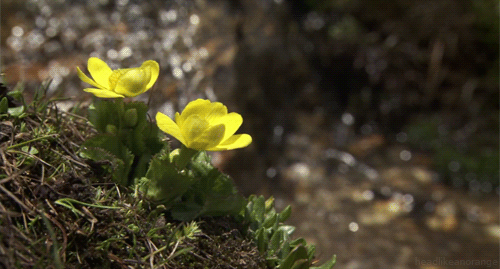
Water, Fire and Air were also common forms of purification. Water from libations, fire from torches and air from the liknon. Now pure, the initiate may approach the Demeter. This can be seen in the final artwork.
Demeter is seen on a kiste surrounded by the materials for Greater Mysteries, snakes wrapped around her knees. She is touching them softly showing her transcended human anxiety. She does not hold the snake, who represents the Mysteries, to Herakles. She turns and waits for Persephone to approach, showing that the initiation is not complete.
These rituals are shown in a separate artwork than the Initiation of Herakles Urn, meaning these rituals must have been preformed during Lesser Mysteries.
Many also like to celebrate Lesser Mysteries as the returning of Persephone to Kore as she returns to her mother. It is shown, as during this time the weather gets warmer, sprigs of flowers begin to pop up.
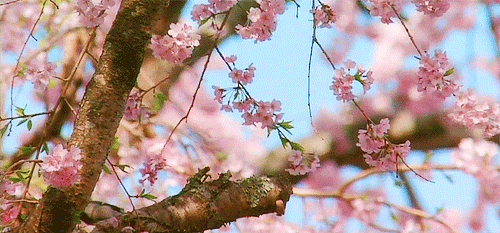
Another large part of Lesser Mysteries was the idea of separation of the body and spirit, and to return oneself to the principles we descended from--"perfect enjoyment of intellectual (spiritual) good"--as sccording to Plato.
This was achieved through purification and rituals to acceptance to the cult.
You can find a Modern Version of Herakles’ Purification here.
#hellenic polytheism#hellenic witch#hellenism#hellenic deities#hellenic polytheistic#hellenic worship#hellenistic#theoi#lady persephone#persephone#lady demeter#demeter#herakles
6 notes
·
View notes